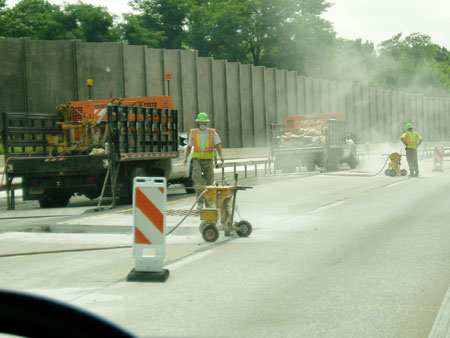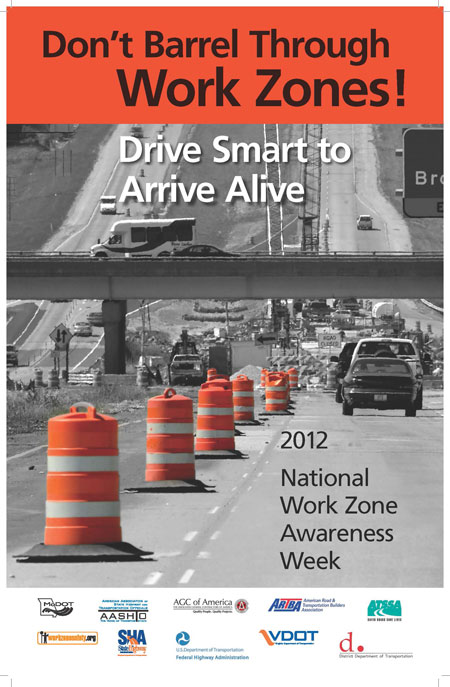U.S. Department of Transportation
Federal Highway Administration
1200 New Jersey Avenue, SE
Washington, DC 20590
202-366-4000
Focus
| Accelerating Infrastructure Innovations |
Publication Number: FHWA-HRT-12-011
Date: March 2012
Printable Version (.pdf, 1.1 mb)
States across the country will remind motorists that safer driving means safer work zones as National Work Zone Awareness Week (NWZAW) 2012 kicks off April 23 on Route 141 near St. Louis, Missouri. "Don't Barrel Through Work Zones" is the theme of the 2012 event.
The Missouri Department of Transportation (MoDOT) is reconstructing a 3.2-km (2-mi) stretch of Route 141, upgrading it from a three-lane road with at-grade intersections to a six-lane freeway with multiple interchanges. The upgraded roadway will enhance the flow of traffic through the region, reduce congestion, and generate an estimated $1 billion in economic activity over the next 20 years.
To keep traffic moving safely through the work zone, MoDOT uses a combination of education, enforcement, and engineering practices. Work zone signs have been enhanced, for example, to make them more visible to motorists. An online map with work zone information helps motorists "drive smart" and better plan their trips. And drivers are encouraged to visit MoDOT's Web site at www.modot.org/workzones/comments.htm to rate work zones and offer suggestions on how to improve them.
Missouri and other States such as Kansas, Mississippi, Oregon, Tennessee, and Washington have also sponsored "Go Orange" campaigns where they light public buildings in orange and encourage citizens to wear the color to show support for NWZAW. In Missouri, more than 90 buildings and landmarks throughout the State have participated in Operation Orange.
"These and other work zone safety awareness strategies States are using stress the importance of protecting both workers and motorists," said Chung Eng of the Federal Highway Administration (FHWA). In 2010, 576 workers and motorists were killed in highway work zones and more than 37,000 were injured. Approximately 85 percent of those killed in work zones are drivers and their passengers.
NWZAW began in 1999 when FHWA, the American Traffic Safety Services Association (ATSSA), and the American Association of State Highway and Transportation Officials (AASHTO) signed a Memorandum of Agreement pledging to increase public awareness of work zone safety issues through a national media campaign. Since then, awareness has continued to grow, with State agencies and other organizations sponsoring high-visibility education and outreach initiatives.
The Arkansas State Highway and Transportation Department, for example, launched a "Know the RED Zones" campaign to highlight areas with significantly reduced capacity during highway construction projects. The campaign's goal is to encourage motorists to be aware of the RED Zones and consider alternate routes, when available, before they approach the construction area. Travel tips and project information are available on the RED Zones Web site at www.arkansashighways.com/Roads/roads2.aspx.
New Jersey will host the 13th Annual New Jersey Work Zone Safety Conference on April 25, 2012, at Rutgers University. Conference topics include traffic control in work zones, maintaining pedestrian access in work zones, and financial implications of work zone accidents. For more information, visit http://cait.rutgers.edu/cait/13th-annual-work-zone-safety-conference.
Work zone safety messages are reaching the youngest passengers as well. The Connecticut Department of Transportation, Connecticut Technology Transfer Center at the University of Connecticut, and Governor's Work Zone Safety Council are sponsoring an "Every Life Counts in Connecticut" roadway safety poster contest for children. Campaign efforts also include outreach to driver training companies, motor transport associations, utility companies, schools, and contractor organizations. To learn more, visit www.ct.gov/dot/cwp/view.asp?a=1410&q=475476.
In addition to ATSSA, AASHTO, FHWA, and individual States, supporters of NWZAW 2012 include the American Road and Transportation Builders Association and the Associated General Contractors of America. More details about NWZAW 2012 and the kick-off event will be posted at www.atssa.com and www.ops.fhwa.dot.gov/wz/outreach/wz_awareness.htm as information becomes available.
New work zone safety resources released by FHWA include a report on Work Zone Road User Costs-Concepts and Applications (Pub No. FHWA-HOP-12-005). The report provides an economic basis for quantifying adverse work zone impacts. These data can then be used to make decisions about how to improve work zone mobility and safety, including selecting preferred alternatives to maintain traffic during construction. Step-by-step instructions are provided for key computations. Three real-world case studies from FHWA's Highways for LIFE program are also presented. To download the publication, visit http://ops.fhwa.dot.gov/wz/resources/publications/fhwahop12005/index.htm.
Also available is FHWA's A Primer on Work Zone Safety and Mobility Performance Measurement (Pub. No. FHWA-HOP-11-033). The primer describes how to better quantify the effects of work zones on travelers, residents, businesses, and the local workforce (see November 2011 Focus). To download a copy of the primer, visit www.ops.fhwa.dot.gov/wz/decision_support/performance-development.htm.
States, contractors, and others can also find guidelines, products, publications, and training resources developed through FHWA's Work Zone Safety Grant program. Since 2006, $27.8 million in grant funds have been distributed to provide highway work zone safety training and develop guidelines to prevent and reduce work zone injuries and fatalities. To date, a minimum of 50,000 individuals have received grant-supported training. More than 45 guidelines and publications, 40 training modules, and 1 software application are now available. For a complete list, as well as a wealth of other work zone safety resources, visit the National Work Zone Safety Information Clearinghouse at www.workzonesafety.org/fhwa_wz_grant.
Another valuable resource is FHWA's Work Zone Safety and Mobility Peer-to-Peer (P2P) program, which matches agencies with experienced transportation professionals who can provide guidance on how to address common challenges in implementing work zone management strategies. To be matched with a peer, call 866-P2P-FHWA (866-727-3492), or send an email to workzoneP2P@dot.gov. There is no cost to participate in the program.
To learn more about FHWA's work zone safety and mobility resources, visit www.ops.fhwa.dot.gov/wz. Information is also available by contacting Chung Eng at FHWA, 202-366-8043 (email: chung.eng@dot.gov).


States across the country will kick off National Work Zone Awareness Week 2012 on April 23. Education and outreach campaigns stress the importance of protecting both workers and motorists.